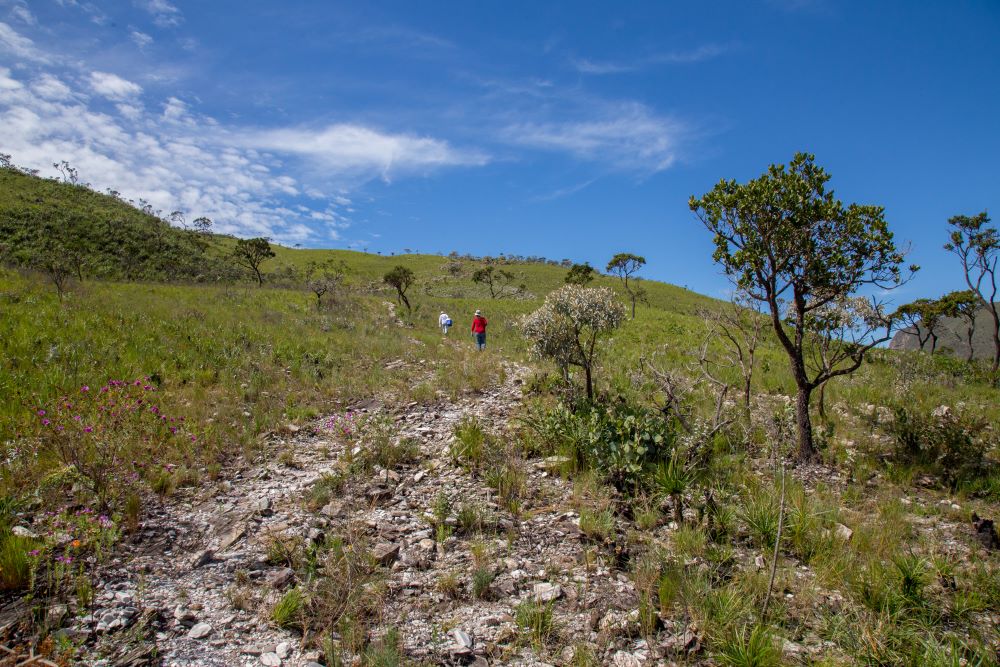


Pioneering work studying microbial communities related to different drought tolerance strategies (photo: Rafael Souza)
Published on 11/19/2025
Agência FAPESP* – Researchers supported by FAPESP have published in the journal Scientific Data an unprecedented and comprehensive set of data on microorganisms associated with plants of the Velloziaceae family in the rupestrian grasslands. These mountainous ecoregions occur in the Cerrado, the Brazilian savannah-like biome. The study identified more than 257,000 bacteria and archaea – one of the largest efforts ever made to characterize the microbiome of Vellozia species. Various plant tissues from four different species, soils, and seasons were examined.
The genetic data and metadata are available on open-access platforms: JGI GOLD, GenBank from the National Center for Biotechnology Information (NCBI), and the European Nucleotide Archive (ENA). This information should stimulate research into plant-microorganism interactions and inspire biotechnological solutions for agriculture in the context of climate change.
The study took place within the framework of the Genomics for Climate Change Research Center (GCCRC), an Applied Research Center (ARCs) set up by FAPESP and the Brazilian Agricultural Research Corporation (EMBRAPA) at the State University of Campinas (UNICAMP).
The rupestrian grasslands are unique ecosystems in central Brazil characterized by extreme conditions, such as nutrient-poor soils and severe droughts. In this challenging environment, Velloziaceae plants – many of which are endemic to these regions – have developed distinct strategies to cope with water scarcity. Some species, such as resurgent Velozia, tolerate desiccation and rehydrate after rain. Others are evergreen and remain hydrated even during drought. This study investigated four species: two resurgent species (Vellozia nivea and Vellozia tubiflora) and two evergreen species (Vellozia intermedia and Vellozia peripherica).
“When we thought about Vellozia’s strategies for dealing with drought, we realized that it’d be important to look beyond the plant itself and also investigate the microorganisms associated with it – both those on the surface of the tissues and those living inside. We believe that this interaction can play a fundamental role in the adaptation of species to such extreme conditions,” explains Isabel Gerhardt, lead researcher at the GCCRC and EMBRAPA Digital Agriculture, as well as co-author of the article.
According to Bárbara Biazotti, a doctoral student at the GCCRC who also signed the paper, the work pioneers the study of microbial communities, particularly bacteria, related to different drought tolerance strategies. “By investigating the microorganisms associated with Vellozia plants, we’ve identified an excellent opportunity to explore Brazil’s rich microbial diversity, with valuable potential for developing new technologies and products aimed at agriculture,” she says.
The article describes how the scientists sequenced 374 samples of leaves, dried sheaths, and aerial and underground roots, as well as soil. The focus was on mapping the microbial diversity in each of these parts. “We made a comprehensive sampling effort to identify all the bacteria present in the different parts of the velozias and in the soil,” explains Otávio Pinto, a bioinformatician at the GCCRC. The researchers also carried out metagenomic analyses of the soil during different periods (rainy and dry) and considered both of the plants’ adaptive strategies.
The results suggest that there are more than 257,000 different types of bacteria in the microenvironment of velozias. “Part of this high number of microorganisms identified is also the result of our comprehensive sampling effort, collecting material from different parts of the four species and at different times of the year,” adds Gerhardt.
A complete description of the seasonal profiles of the bacteria associated with the velozias will make it possible to investigate whether there are significant differences between the dry and rainy periods or between the evergreen and resurgent species. This is the next step for the GCCRC scientists.
Open science and data articles
The study was published in the “data descriptor” format, which prioritizes detailed information sharing for widespread use by the scientific community. “Our aim was to make the data available in an organized way, in an internationally recognized standard, and in an open repository so that other researchers can test their hypotheses and make comparisons between different studies,” explains Ricardo Dante, principal researcher at the GCCRC, EMBRAPA Digital Agriculture, and author of the article.
“The wide dissemination of these data can benefit not only ecology and microbiology, but also applied studies such as conservation strategies and biotechnology for soil management in arid conditions,” concludes Gerhardt.
The dataset is publicly accessible, enabling researchers from various fields to explore it and advance our understanding of the adaptations of plants and microorganisms in rupestrian grasslands.
Phosphorus uptake in extreme environments
As well as being home to flora that is highly adapted to water scarcity, rupestrian grasslands are also a habitat for bacteria capable of making scarce nutrients more available to plants. In a previous study, GCCRC researchers identified that microorganisms associated with the roots of species from the Velloziaceae family (Vellozia epidendroides and Barbacenia macrantha) have a greater number of genes related to phosphorus solubilization compared to other plant species and environments. Phosphorus is an essential nutrient for plant survival, but it is difficult to access in highly weathered tropical soils (read more at: agencia.fapesp.br/40441).
These bacteria act as silent allies for plants by transforming insoluble phosphorus compounds into forms that can be absorbed, which is crucial for vegetation to persist in nutrient-poor soil. Understanding these interactions could contribute to the development of sustainable agricultural technologies, such as biofertilizers that increase phosphorus use efficiency in crops.
The article “Seasonal bacterial profiles of Vellozia with distinct drought adaptations in the megadiverse campos rupestres” can be read at: www.nature.com/articles/s41597-025-04984-z.
* With information from Paula Drummond of the GCCRC
Source: https://agencia.fapesp.br/56533